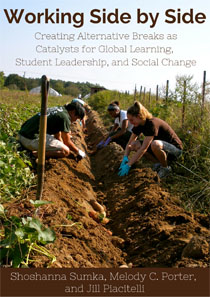A handbook for changing the world
{{youtube:medium|bLmxDcqZgS4}}
Many people enter young adulthood with a deep desire to change the world but are unsure of how to accomplish that task or even where to begin.
Melody Porter, associate director of William & Mary’s Office of Community Engagement, says that a good starting point is just recognizing “how connected we are with one another.” It’s a revelation she’s seen students have time after time on alternative-break trips as they’ve shared meals with those experiencing homelessness or talked with people their age in detention centers.
“There starts to be that connection of human spirit, of understanding, of empathy that is what really shifts things. I think that’s what it takes for our world to change, and I think a lot of people are doing that,” she said. “What’s possible is greater when we do that together, when we work in a focused way together and share goals that we develop together. That’s what alterative breaks are about, teaching people how to do that, and I think the more we can do that with alternative break programs across the country, the more we’ll see that change happen.”
 Porter recently co-authored a book on how to create and sustain such programs, which offer students the chance to work with community partners on social justice issues in areas ranging from their own backyard to countries around the world. Working Side by Side: Creating Alternative Breaks as Catalysts for Global Learning, Student Leadership, and Social Change, authored by Porter, Shoshanna Sumka and Jill Piacitelli, is the first book of its kind and offers “part theory, part practice and part vision for the future of these kinds of programs,” said Porter.
Porter recently co-authored a book on how to create and sustain such programs, which offer students the chance to work with community partners on social justice issues in areas ranging from their own backyard to countries around the world. Working Side by Side: Creating Alternative Breaks as Catalysts for Global Learning, Student Leadership, and Social Change, authored by Porter, Shoshanna Sumka and Jill Piacitelli, is the first book of its kind and offers “part theory, part practice and part vision for the future of these kinds of programs,” said Porter.
“Our hope is that students and staff people who lead alternative break programs on campuses will read it, but we also wrote it with the idea in mind that it could really reach out to faculty who do service-learning and engaged scholarship, to people who lead global studies, to community partners who host alternative break groups to learn how to make the relationships work better on all sides,” she said.
The book begins with an explanation of justice theory for service-learning and community engagement and then delves into global learning and creating social change – moving from theory into practical tips on things like planning effective fundraisers, structuring a program with real student leadership and measuring impact.
The book also explores the concept of active citizenship, which is becoming a buzzword among nonprofits, universities and corporations Porter noted.
“And what I’m excited about is in this book, we articulate a clear vision for what active citizenship is and a way to help develop active citizenship,” she said. “It’s sort of cutting through the jargon … and showing that this is a real thing that can happen in people’s lives, that we can develop with intentional steps and see outcomes in communities because of that work together.”
Porter said that she drew on her personal volunteer experiences working with diverse communities from Philadelphia to Johannesburg as well as her work with W&M’s own alternative break program, Branch Out, to inform her contributions to the book.
The students that she’s worked with throughout the years were particularly inspiring, she said, adding that they are always pushing her.
“They ask really hard questions; anyone who’s worked with our students knows that,” she said. “But they also throw themselves into the work and show what’s possible because of that. They’re willing to set aside other priorities in order to make their trips good, to be able to connect with each other and learn from each other. … When I see students doing that, when I work closely with them and am challenged in that way, it just ups my belief in the possibility for real change through them and with them. I’ve learned a ton from them.”
The authors also reached out to dozens of students and staff leaders with alternative break programs across the country to hear about their experiences, challenges and recommendations. All three of the authors have close ties to Break Away, a national nonprofit that promotes alternative breaks. Porter is currently the board chair.
“We [at William & Mary] have done a lot of great leadership in this field, but what this book has done has allowed me to learn from others,” said Porter. “As a collection of all of those ideas, informed by my coauthors’ and my experience, I think it is really valuable and helps to bring the alternative break movement to the next step.”
Such collaboration is key if one wants to change the world, said Porter, noting that the world needs people who “are not looking to go it alone but who are looking to learn from each other and develop things together.
“Collaborators is what we need, but people who aren’t going to take a back seat either, who are going to say, when they see a gap, when they see a need, ‘I’m willing to go there. Will you come there with me? Let’s get this done together.’”














